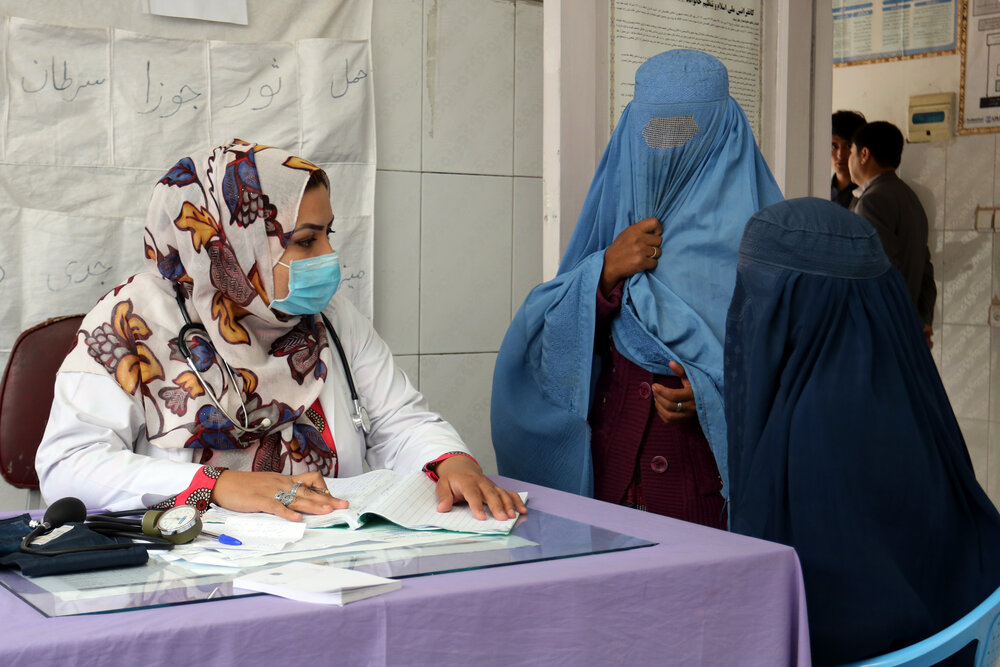
Story Highlights:
- Thousands of residents in a remote district in Samangan province faced long distances and difficult conditions to access health services in the provincial capital.
- Under the Afghanistan Sehatmandi Project, a basic package of health services in the district health center has brought health care closer to residents.
- The project is a follow-on of the System Enhancement for Health Action in Transition program and seeks to improve quality of health, nutrition, and family planning services across the country.
HAZRAT SULTAN DISTRICT, Samangan Province – On a cold, early morning, Din Muhammad (name changed), 60, walks toward the Hazrat Sultan Comprehensive Health Center (CHC), gripping a cane in his trembling hand. He has come to the health center to see a doctor. Din Muhammad is a laborer and earns a living working for others on their farmland. The hardships of labor and years of suffering from stomach issues have made him a very thin man.
Din Muhammad routinely visits the health center for check-ups and medicine, located just 5 kilometers from Gargari village where he lives. It is a short distance compared to the 24 kilometers he had to travel to Aybak, the provincial capital of Samangan, to seek medical care. The shortened journey allows him to visit the health center more frequently. “Everyone from our village comes here for treatment and the [health center] personnel treats us nicely,” Din Muhammad says. “The health center is helpful as it treats our problems.”
The CHC is located in the remote district of Hazrat Sultan in Samangan province in northern Afghanistan. It was established more than 40 years ago as a health outpost but was converted to a health center in 2017. It now has several units offering services such as outpatient, midwifery, vaccination, laboratory, nutrition, and mental health treatment. It also has a pharmacy and an ambulance. There are 20 employees, including health and support staff, serving 24,000 inhabitants in the district. The CHC sees an average of 300 patients a day and has an inpatient facility for up to five patients.
Although it is a cold and rainy day, many people have come to the health center for check-ups and vaccinations. Ara (name changed), 33, has traveled 13 kilometers from another village to have her one-year-old vaccinated. “The doctors gave us medicine and vaccinated my child,” says the mother of six. “I am happy with the health center services.”
"Everyone from our village comes here for treatment and the [health center] personnel treats us nicely. The health center is helpful as it treats our problems. "
- resident, Hazrat Sultan district
Hazrat Sultan CHC has been providing a basic package of health services (BPHS) since July 2017. It is one of the 47 health facilities, such as district hospitals, comprehensive health centers, and basic health centers, delivering BPHS in Samangan province. The health facilities have brought quality health services closer to residents in remote areas.
The provision of BPHS and an essential package of hospital services (EPHS) across Afghanistan is supported by the Afghanistan Sehatmandi Project, which aims to increase the utilization and quality of health, nutrition, and family planning services across the country. The Sehatmandi project, implemented by the Ministry of Public Health (MoPH), is supported by the Afghanistan Reconstruction Trust Fund (ARTF), managed by the World Bank on behalf of 34 donors, International Development Association (IDA), the World Bank Group’s fund for the poorest countries, and the Global Financing Facility(GFF), a multi-stakeholder partnership that prioritizes high impact but underinvested areas of health.
Sehatmandi is a follow-on project of the System Enhancement for Health Action in Transition (SEHAT) program, which closed in June 2018. The MoPH's SEHAT program aimed to expand the scope, quality, and coverage of health services, particularly to vulnerable groups and was supported by the ARTF and IDA, in partnership with multiple donors.
Demand for Quality Services
In Samangan province, MoPH has contracted nongovernmental organizations like Social and Health Development Program (SHDP) and Relief Humanitarian Development Organization (RHDO) to provide BPHS in the 47 heath facilities under the Sehatmandi Project.
Health councils have been set up to boost relations between the community and health facilities. The health councils include community members who help health care staff understand local health needs as well as involve the community in health center activities.
The health council has played a key role in expanding the reach of health services by engaging with the local population and raising awareness of health issues. General knowledge of health issues has increased as well as demand for quality health care, confirms the SHDP Deputy Technical Project Manager of the Sehatmandi Project in Samangan province. “In the past, people would request that we establish more health centers. Now they ask us to increase the quality of the health services they receive, which means people understand their needs,” he says.
The Hazrat Sultan health council is a good example of the community’s support of a health facility. The health council, with the help of the local health directorate, has raised funds to build a small building for emergency cases, which will mean that local residents will not need to travel long distances to another health facility in such cases.
Addressing Challenges
There are still many challenges to overcome in Samangan province. For example, 11 out of the 47 health facilities operate in buildings that are not up to standard for a health facility. New buildings are being constructed under the Sehatmandi Project to rehouse these facilities.
Another challenge is the shortage of female health professionals. MoPH mandates employment of at least two female health professionals —a nurse and a midwife—per basic health center. To increase the number of female health professionals, 48 female high school graduates have undergone Community Midwifery Education and Community Health Nursing Education programs. The students are expected to graduate by late 2019 and join health facilities close to where they live.